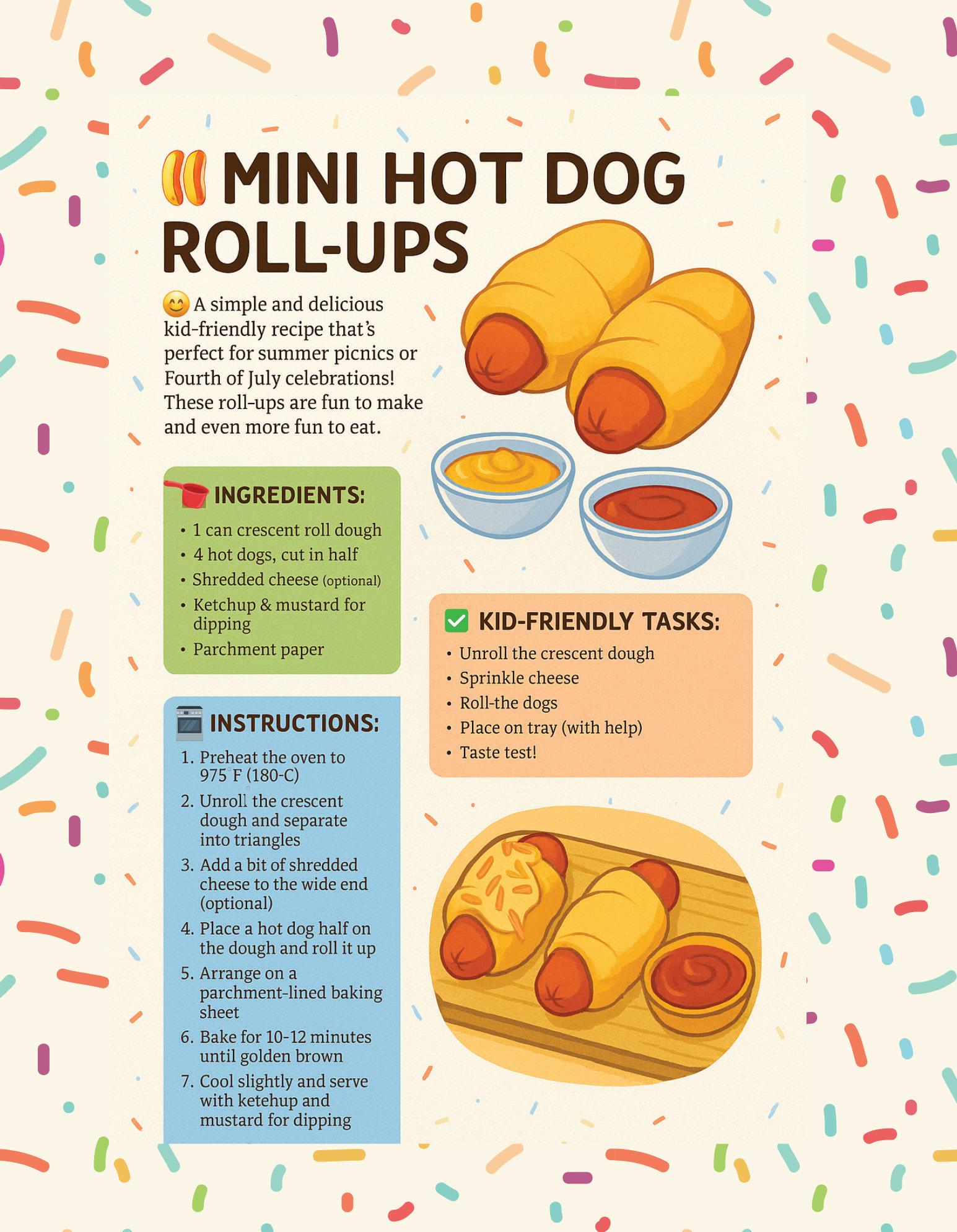
Road

Revival

The
Road













The
Road









The Cooper Family – Flagstaff, AZ
Every Fourth of July, the Cooper family heads to a quiet hilltop behind their neighborhood with one very important item: an old red-and-blue quilt that’s been in the family for three generations. “It’s a little worn at the edges,” laughs Mrs. Cooper, “but it holds so many memories.” They pack sandwiches, sparklers, and a radio tuned to patriotic music. As the fireworks begin, the whole family lies on the quilt, telling stories of past Fourths—like the time Grandpa accidentally lit all the sparklers at once. It’s not about the spectacle for them—it’s about slowing down, being present, and honoring both the country and their roots.
The Martinez Family – San Antonio, TX
In the Martinez household, the 4th of July starts with drums and ribbon wands because it’s time for Nana’s Backyard Parade. What began years ago with just three kids pulling a wagon is now a full-on mini parade with cousins, pets in costume, and decorated bikes. “Everyone gets a prize,” says 8-year-old Clara. “Even Uncle Joe, and he just walks with a flag!” After the parade, Nana serves dinner under red, white, and blue streamers. It’s silly, it’s homemade and it’s theirs. “We may not have big fireworks,” Nana says, “but we have big love.”
The Chen Family – Sacramento, CA
The Chen family has created a beautiful tradition: writing annual “Letters to America.” After dinner on the 4th, each family member—from the youngest to the oldest—writes a short letter expressing what they love about their country and what they hope for its future. The letters are saved in a scrapbook they started over 15 years ago. “It reminds us to be thankful,” says Mr. Chen, “and to think about how we can contribute.” Afterward, they light paper lanterns and send them into the sky. “It’s our way of putting those hopes out into the world.”
The Rivers Family – Lake Orion, MI
For the Rivers family, the 4th of July means a weekend of togetherness at their lake cabin. After a day of swimming, paddle boating, and grilling, they gather around the firepit with mugs of hot cocoa—even in July. As dusk falls, Dad reads from a journal filled with family entries from past holidays. They write new reflections each year: favorite moments, proud memories, and one big group wish for the year ahead. “We get to laugh, cry, and remember,” says teenage daughter Lila. “It’s the one night we all feel completely connected.”





Rae Indigo, is an esteemed yogi and martial artist known worldwide for her unique courses on wellbeing, including mind science, meditation, and breathwork. As a biochemist, she also pioneered a line of high-end, organic skincare. When she’s not teaching others how to live stress-free, she’s likely surrounded by the love of her three feisty Pomeranians.

Hello, wonderful readers!
This month, we’re exploring box breathing, a gentle, accessible breathing technique that can bring a sense of peace, sharpen focus, and ease stress for both kids and those who care for them.
Known as square breathing, this method is simple to learn, adaptable to different needs, and requires nothing more than your breath. Whether you’re a young person managing big feelings, a caregiver balancing a busy day, or a family looking for ways to connect and find calm together, box breathing offers a nurturing way to bring balance to body and mind.
Let’s dive into what it is, why it’s so effective, and how to make it a part of your daily life, with ideas tailored for kids with unique abilities and their supportive caregivers.
Box breathing is named for its four-part structure, like the equal sides of a square: you breathe in, hold, breathe out, and hold again, each for the same amount of time, often around four seconds. Picture tracing a square in your mind with each breath, creating a steady, comforting rhythm that feels grounding. For kids with diverse abilities,
especially those who experience sensory sensitivities, anxiety, or emotional overwhelm, this predictable pattern can feel like a warm hug, offering a sense of control in moments that feel chaotic.
Caregivers, too, can find relief in this practice, using it to stay centered during demanding times, like navigating medical appointments or soothing a tough moment. Best of all, box breathing is flexible, it can be done sitting, lying down, or even in a wheelchair, making it welcoming for kids with different physical abilities or sensory needs.
Why does box breathing feel so calming?
When we’re stressed, our bodies can shift into high gear, with quick, shallow breaths that make us feel jittery or unsettled. This can be especially intense for kids with unique needs, who may feel sensory or emotional overload more strongly.
Box breathing gently slows everything down, sending a message to the body’s nervous system, the part that handles stress and relaxation, to switch into a “rest and recharge” mode. When you breathe in slowly, hold, breathe out, and hold
again, you help lower your heart rate and quiet your mind, like pressing a gentle reset button. Research supports this: slow, rhythmic breathing can ease anxiety, improve focus, and even help with sleep, which can be a challenge for kids with ongoing health needs or their caregivers. For kids who feel overwhelmed by loud sounds, bright lights, or big emotions, this practice can be a soft anchor, helping them feel safe and steady.
One of the most beautiful benefits of box breathing is how it supports emotional balance, which can be especially meaningful for kids with developmental, neurological, or sensory differences. By focusing on the breath and counting each step, kids can shift their attention away from overwhelming feelings or sensations, giving their minds a moment to rest.
This can be a lifeline for kids who experience racing thoughts, sensory sensitivities, or challenges with self-regulation, such as those with autism or ADHD. For instance, a child who feels upset during a change in routine might find comfort in the steady rhythm of box breathing, helping them feel more in control. Caregivers can also use it to stay patient and grounded,
creating a calm presence that supports both them and their child during tough moments.
Box breathing also boosts focus and mental clarity, which can be a gift for kids working on school tasks or daily activities that require attention. The slow, deep breaths increase oxygen to the brain, helping kids feel more alert and ready to engage.
This can be especially helpful for kids with cognitive or attention challenges, as the structured rhythm provides a clear focus point. Even Navy SEALs use box breathing to stay sharp during high-pressure situations, and kids can tap into that same sense of clarity for tasks like homework or therapy exercises.
For caregivers, practicing box breathing before a busy day can sharpen focus and energy, making it easier to juggle caregiving responsibilities with calm confidence. Physically, box breathing supports overall wellbeing in gentle ways. The deep inhalations expand lung capacity and improve oxygen flow, which can boost energy and support heart health.
The slow exhales and pauses stimulate a part of the nervous system that helps with relaxation, digestion, and even sleep. For kids who struggle with falling asleep or staying calm due to medical conditions or sensory sensitivities, box breathing can be a soothing bedtime ritual. Caregivers, too, can use it to unwind after a long day, promoting restful sleep and reducing the physical toll of stress. Best of all, it’s free, portable, and needs no special tools, making it a gift for families of all backgrounds.
To start box breathing, find a quiet, comfortable space where
you and your child feel at ease, though with practice, it can be done anywhere, during a car ride, at school, or even in a hospital waiting room. For kids who use wheelchairs or have limited mobility, they can stay in their preferred position, whether sitting or lying down. Caregivers can model the practice, making it a shared moment of connection.
Begin by sitting or lying in a relaxed position, with shoulders soft and hands resting comfortably. If closing the eyes feels overwhelming, especially for kids with sensory sensitivities, try focusing on a favorite toy, a calming picture, or even a caregiver’s gentle smile. Start by breathing out fully through the mouth, letting go of any tension. Then, breathe in slowly through the nose for a count of four, feeling the belly rise softly, like filling a balloon.
If nose breathing is tricky for kids with certain medical conditions, breathing through the mouth works just as well. Hold the breath for four seconds, noticing the quiet moment of stillness. Then, exhale slowly through the mouth for four seconds, like blowing out a candle gently. Finally, pause for four seconds before starting again.
This completes one cycle. Try four to six cycles, about five minutes, but even one or two cycles can make a difference. For younger kids or those new to the practice, use a shorter count, like two or three seconds, and gradually build up as they feel more comfortable.
To make it fun and engaging, turn box breathing into a game. Imagine tracing a sparkly square in the air with each breath or pretend to blow bubbles during
the exhale. For kids who use communication devices or have verbal challenges, caregivers can guide the rhythm with gentle taps or visual cues, like raising fingers for each count. If a child feels dizzy or uncomfortable, pause and return to normal breathing, trying again when they’re ready.
The key is to go at their pace, celebrating small steps. Caregivers can join in, modeling the practice and creating a shared moment of calm, which can strengthen the bond between you. Incorporating box breathing into daily life can be a nurturing ritual. Try it in the morning to start the day with calm, or at night to ease into sleep. For kids with sensory sensitivities, use it before overwhelming activities, like doctor’s visits or loud events, to help them feel grounded.
Caregivers can weave it into their routine, too, using it during a quiet moment to recharge. Over time, box breathing can become a comforting habit, like a trusted friend you turn to in tough moments. For extra fun, pair it with a favorite song’s rhythm or a calming phrase, like “I am strong,” to make it feel personal and empowering.
Box breathing’s magic lies in its simplicity and warmth, a practice that welcomes kids with diverse abilities and their caregivers into a moment of peace. Its gifts, calm, focus, emotional balance, and physical ease, make it a treasure for families navigating unique challenges.
By taking a few minutes each day to breathe together, you and your child can find a steady rhythm, building resilience and connection, one gentle breath at a time.


As parents, we often find ourselves saying “no” more than we’d like—not because we want to be party poopers, but because life is busy, messy, and structured. But what if, just for this summer, we chose a different approach? What if we embraced a “Summer of Yes”?
Saying “yes” doesn’t mean throwing out all boundaries or routines. It means creating room for spontaneity, playfulness, and child-led magic. It’s about recognizing that not every moment has to be planned or productive—sometimes the best memories are born from unexpected “yeses.”
Children are naturally curious and imaginative. When we respond to their ideas with openness— even when they seem inconvenient or silly—we’re telling them that their thoughts matter. We build trust. We foster creativity. And we allow ourselves to reconnect with a sense of wonder we may have forgotten.
A spontaneous water balloon fight, a messy backyard picnic at sunset, or staying up past bedtime to watch the stars—these are the “yes” moments that stick. They say, “I see you.
I hear you. And I want to experience this with you.”
• Yes to unstructured time: Instead of overscheduling every day, leave room for boredom. You’d be amazed at what kids dream up when they’re given space.
• Yes to silly ideas: Build the cardboard spaceship. Wear pajamas to the grocery store. Let them host a “restaurant” in your kitchen. Lean in!
• Yes to connection over control: When a child asks, “Can I help you?” even if it slows you down—say yes. These shared moments teach them life skills and strengthen your bond.
One of the most powerful parts of the Summer of Yes is letting your child lead. Invite them to plan a family day. Ask, “What would your perfect summer day look like?” You may end up chasing butterflies, painting rocks, or baking cupcakes at 10 a.m.—and it might be exactly what you both needed.
When kids feel like their voice is valued in the family,
they’re more likely to open up, communicate their needs, and feel confident exploring the world around them.
The Summer of Yes doesn’t mean abandoning limits. Kids thrive when they know what’s expected. You can still say “yes” within boundaries:
“Yes, you can have ice cream—after dinner.”
“Yes, you can stay up late—on Fridays.”
“Yes, let’s try that—safely, and with help.”
In the end, kids won’t remember how clean the house was or how many errands got done. They’ll remember the day Mom said yes to building a blanket fort that took over the living room, or when Dad agreed to jump into the pool with all his clothes on.
So this summer, let’s choose presence over perfection. Let’s lean into the laughter, the chaos, and the joy. Let’s say yes—and watch our relationships with our children bloom. Because sometimes, the smallest yes becomes the biggest memory.


Jennifer Affronti is a former model, actress, stage performer, television personality and burlesque dancer. Her personal journey through chronic illness led her to completely change her career path to become a resource and advocate for people who want to live happier, healthier and more fulfilling lives. She is now a certified Holistic Health Coach and the founder of Wholelistically Healing, where she focuses on empowering individuals to take control of their health and well-being through personalized coaching and guidance.

I love this recipe for summer. It is light and tropical and doesn’t take long to make. My Mom first made another version of this when I was a child, and one day I wanted to make a tropical version of what she made. My Mango Salsa Shrimp was born. I make my rice in advance. The reason I do this is because of resistant starch. If you cool your rice and then reheat it, it creates resistant starch. Resistant starch improves glucose control, gut health and is ideal for those on a low carb diet. I hope you enjoy it!
First, things first! Let’s get happy! If you can, turn on your favorite music and get ready to dance in the kitchen! And don’t forget to say a little blessing while you create this. Everyone will taste your gratitude and happiness.
What you will need:
• 1 lb bag of shrimp peeled and deveined
• 3 ripe mangos diced
• 1 small red onion diced
• 1 jalapeno pepper diced
• ½ red bell pepper diced
• 1 lime juiced or 1 tablespoon of lime juice
• Pinch of sea salt
• 3 cloves of garlic minced
• 1 cup of butter (separated ½ cup)
• 1 cup of uncooked rice
• 1 tablespoon of coconut oil
• 1 ½ cups of coconut milk
• ½ cup of water
Directions for Coconut Rice:
1. Clean your rice twice and make sure it runs clean.
2. Add your cleaned rice into your rice maker and add coconut milk, coconut oil and water. Let cook for 20-25 minutes.
3. Let chill for at least three hours before you reheat.
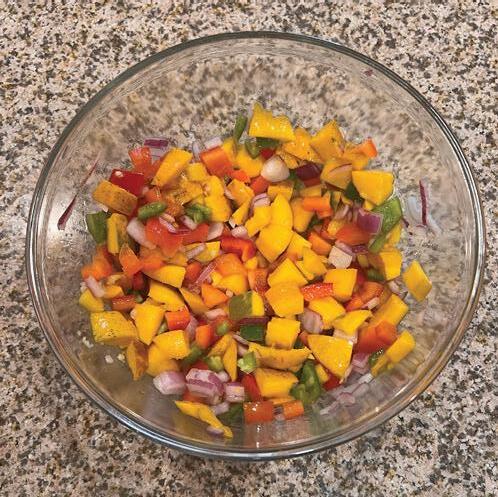
Directions for Mango Salsa:
1. Add diced mangos, diced red onions, diced bell peppers, lime juice and pinch of sea salt in a bowl and mix together.
2. Let chill until ready to mix with shrimp.
Directions for Shrimp:
1. Preheat your oven to 400’.
2. Melt ½ cup of butter and add 3 cloves of garlic minced.

3. Place parchment paper on a cookie sheet and place your thawed 1 lb of shrimp in a single layer.
4. Pour the melted butter and garlic over everything.
5. Bake for 8-10 minutes or until pink.

Directions for Mango Salsa Shrimp & Rice:
1. In a large pan, melt ¼ cup of butter on medium heat.
2. Add your chilled rice and stir. Let the rice soak up the butter.
3. Add your mango salsa and stir together.
4. Finally add your shrimp and garlic butter from your cookie sheet and mix it all together until it is completely distributed.
5. Serve and Enjoy!!





Theres something timeless about a family road trip on the open road, the playlist humming through the speakers, snacks within arm’s reach, and the unfiltered laughter that fills the car. But anyone who’s traveled with kids knows that what starts as a scenic drive can quickly dissolve into backseat bickering and constant cries of Are we there yet?
The good news? With a little creativity and intention, the journey can become just as magical as the destination. This summer, give your family road trips a joyful refresh with bonding games, snack-time saviors, storytelling prompts, and music moments that create memories to last a lifetime.
Plan with a Purpose but Leave Room for Magic
Kids love surprises, but they also thrive on structure. Before hitting the road, loop them into the planning process. Give them a say in which stops to make, which snacks to pack, or what songs go on the road trip playlist. Even small choices give kids a sense of ownership and excitement.
Interactive Tip:
Create a Trip Treasures checklist with your kids. Include:
• Try a new snack
• Take a photo with a funny roadside sign
• Sing a song together
• Complement each family member once
• Spot a wild animal
Give them stickers to mark off accomplishments along the way!

Nothing brings a car full of people together quite like a shared jam session. Music has the power to energize, soothe, and spark conversations between generations.
Create multiple playlists, like:
• Wake-Up & Roll for morning energy
• Cruise Control for scenic stretches
• Backseat DJs (kid-picked tunes)
• Throwback Tracks (songs from your own childhood road trips)
Interactive Prompt:
Ask everyone: What’s one song that reminds you of a happy memory? Add it to the playlist and talk about it when it plays.
Tell Me a Story: Spark Connection through Shared Imagination
Long drives are the perfect
time to escape into a story real or imagined. Make storytelling a family event with these ideas:
1. Progressive Stories: One person starts a story with a sentence like Once upon a time in a town made of jellybeans... and each person adds a sentence as you go around the car.
2. Roadside Riddles: I spy with my little eye... but level it up by describing something you passed five minutes ago to test observation skills.
3. Family Flashbacks: Ask: What’s your funniest vacation memory? or What was the best surprise you ever had? Even parents can share their childhood road trip tales.
Bonus Bonding Game:
Create a fictional character together and imagine what kind of summer road trip they’d be on. What snacks
would they pack? What music would they love? What’s their secret talent?
Bring back the classics or invent your own! Try these boredom-busting ideas:
• License Plate Hunt: Try to spot plates from all 50 states. Create teams and race to 25!
• 20 Questions Vacation Edition: Only vacationthemed answers allowed.
• Would You Rather?: Would you rather swim in Jello or have a picnic on the moon?
• Soundtrack This Scene: Look out the window and pretend the world is a movie. What kind of song would be playing right now?
Road trip hunger hits differently. Keep hunger at bay and moods high with these clever snack tips:
1. DIY Snack Boxes:
Use a craft organizer to create personal snack packs filled with trail mix, crackers, fruit bites, and mini treats.
2. No-Mess Must-Haves:
Choose low-crumb, easy-tohold snacks like cheese sticks, grapes, granola bars, and squeezable applesauce.
3. Hydration Station:
Bring reusable bottles for everyone and keep a small cooler within reach.
Give each kid a small snack budget and let them pick 23 special snacks at the store.
Create Rituals That Make the Car Feel Like Home
• The Daily Recap: Share a High, Low, and LOL moment each night.
• Mile Marker Moments: Every 100 miles, pause to give out a small surprise.
• Gratitude Circle: Go around the car sharing one thing each person is grateful for.
Start capturing memories during the trip:
• Road Trip Journal: Let kids draw or write about daily adventures.
• Backseat Polaroids: Use a simple instant camera to snap photos.
• Podcast Diaries: Use a voice recorder app to capture short reflections.
• Keep a garbage bag and wipes within reach.
• Store a Just in Case kit: paper towels, band-aids, extra charger, sunscreen.
• Switch seats occasionally.
• Bring a mini tray for backseat drawing and games.
It’s Not About the Miles it’s About the Moments
Sure, you might hit traffic or spills, but those things don’t erase what really matters: time together.
When you shift from getting there to being here, even a drive becomes a space for discovery, joy, and connection.
Pack the snacks, cue the playlist, and open your hearts. This summer, the journey is the destination.


There’s something magical about summer-sunshine, freedom, and long afternoons filled with possibility. It’s the perfect season to spark a love for learning in the most natural way: through play. “Sun-Kissed Science” is all about using the sun as your lab partner and your backyard as a classroom, creating meaningful bonding time between parents and kids.

Science doesn’t have to mean beakers and lab coats. Some of the most memorable discoveries come from the simplest experiments, especially when guided by curiosity and shared laughter. With just a few household items and a dash of sunshine, families can explore real scientific principles while making memories that stick.
Outdoor science lets kids get hands-on while soaking in fresh air and vitamin D. It also turns everyday moments into teachable ones-encouraging observation, patience, and problem-solving. And when parents join in, it becomes more than just a lesson; it becomes a shared adventure.
Turn a pizza box, foil, and plastic wrap into a solar oven! Line the box with black paper, foil, and plastic wrap to trap heat, then place your s’mores inside and let the sun do the melting. Kids learn about solar energy and heat absorption while enjoying a delicious treat.
Place ice cubes on different surfaces-metal, grass, concrete, or plastic-and predict which will melt the fastest. Use a stopwatch to track the time. Talk about conduction and how different materials absorb or reflect heat.
Use chalk to trace your child’s shadow in the morning, then revisit the same spot every hour to retrace. Watch how the shadow moves and changes size. This experiment
teaches the relationship between the sun’s position and time of day-and can feel a little like magic to young minds.
On a sunny day, spray a mist of water into the air with a hose and have your child stand with the sun behind them. A rainbow appears, and you can explain how light refracts through water droplets. Bonus: it’s a great way to cool off, too!
5.
Draw with lemon juice on white paper and let it sit in the sun. Over time, the invisible message or design will turn brown as the sun oxidizes the juice-like secret ink! It’s a fun way to learn about chemical reactions and UV exposure.
These experiments aren’t just educational-they create quality time. When parents kneel beside their children in the dirt, laugh over melted marshmallows, or guess which ice cube will win the race, something beautiful happens: connection.
Science teaches us to wonder, to test, to explore. But it also teaches us to do it together. So this summer, roll up your sleeves, grab a few supplies, and step into the sun. Because the best kind of learning is the kind you do side by sidewith joy, discovery, and love lighting the way.




Fireworks can be magical for some and overwhelming for others—especially children with autism, sensory sensitivities, or veterans with PTSD. Offer quiet zones with noise-canceling headphones, fidget toys, or simple activities like coloring or bubbles. If you’re hosting fireworks, give advance notice and consider a “low-boom” alternative or a sparkler-only hour for a quieter celebration.
If you’re hosting a party in your backyard, a park, or a public space, make sure there’s easy access for wheelchairs and strollers. Keep paths clear, and make sure restrooms are accessible too.
Set up games that everyone can enjoy—like cornhole, giant Jenga, ring toss, or story circles. Make participation about being present, not performance. If you’re playing music or hosting group activities, offer instructions in both verbal and visual formats.
Every family has a unique relationship with the meaning of “freedom.” Create a space for storytelling. Let kids interview their grandparents. Share a board or wall where guests can write what freedom means to them.
Consider incorporating readings or short poems
that honor the diversity of American experiences— from Indigenous voices to immigrant journeys, and those still fighting for equal rights. These moments spark deep connection and remind us of what unites us.
When planning your menu, ask guests ahead about food allergies or dietary restrictions. Include a variety of options like gluten-free snacks, plantbased dishes, and kid-friendly favorites. Labeling dishes with colorful signs or allergen info shows thoughtfulness and care, and it makes everyone feel seen.
Designate a “Freedom Photo Spot” with flags, fun props, and signs that say things like “Proud to Be Me” or “United in Kindness.” Make sure it’s easy for all ages and abilities to access, and take turns helping one another capture those sweet moments.
When we make space for everyone to feel included, we live out the true spirit of Independence Day. This July 4th, let your celebration be a tapestry of laughter, compassion, and connection—a reminder that joy grows stronger when shared by all.

Happy Fourth of July from Stories of Perseverance to yours!
By Rissa

Do you ever feel like your dog has too much high energy & needs a job? Maybe you feel like your dog is bored & could be acting out, or maybe you are just seeking something new to do with your furry friend. Dogs are naturally drawn to sniffing & exploring scents, so what if I told you that you can teach your dog to sniff & track certain scents from the comfort of your own home. Teaching your dog your dog scent work offers plenty of benefits which include mental stimulation & physical exercise.
Scent work provides a satisfying mental challenge & can be beneficial for dogs of all ages, all breeds, & even for those with behavioral issues like reactivity. Research has
found that dogs that have been specifically trained to pick up certain scents have a better ability to complete tasks, which gives them a better cognitive function & ability to control themselves. Scent work allows them to use their innate abilities to satisfy & fulfill their natural instincts & behaviors. So, if you are ready to experience a world of fun for you & your dog, I’m here to break it down into easy steps to try.
Start off by engaging their natural sniffing instinct, introducing scents in small, controlled ways, & rewarding them for finding the scent. As your dog gets better at finding the scent you’ll gradually increase the difficulty &
distance of the scent hide. You want to keep sessions short & positive while keeping your dog engaged. You’ll need to build motivation, if your dog is not naturally motivated, you can use high value treats to start.
If your dog is treat or toy motivated, you can use either as a motivator. If you are unsure of what you need to start or do not know what scents are best & safe for your dog, I have a list of items & scents commonly used for scent training. You will need cotton swabs, essential oils such as birch, anise, clove, cypress, lemongrass, & myrrh can be also used. You will also need scent containers like a small metal tin with holes in the lid or a colander to use for introducing scents. Mason jars are perfect since glass is one of the least porous materials, it helps contain the essential oil scent.
Be careful not to crosscontaminate by adding your own scent to the swab so it’s best to use tweezers or gloves when handling or adding oil onto the swab. (always use diluted essential oils, as concentrated oils can be toxic to dogs.) Prep the odor & scent vessel in a room far away from where you will be working with your dog.
Wearing disposable gloves as you apply two drops of essential oil to each cotton swab & put into scent
containers. Then you start with easy tasks like holding the scent container in one hand & holding a treat in another keep your hands about a foot apart. When your dog sniffs the source, immediately reward them with a verbal praise & treat reward. After a few reps, switch the scent to your other hand so your dog doesn’t rely on memory to know which hand to go to. You’re ready to move on if your dog can correctly identify the scent in each hand within a few seconds, three times in a row.
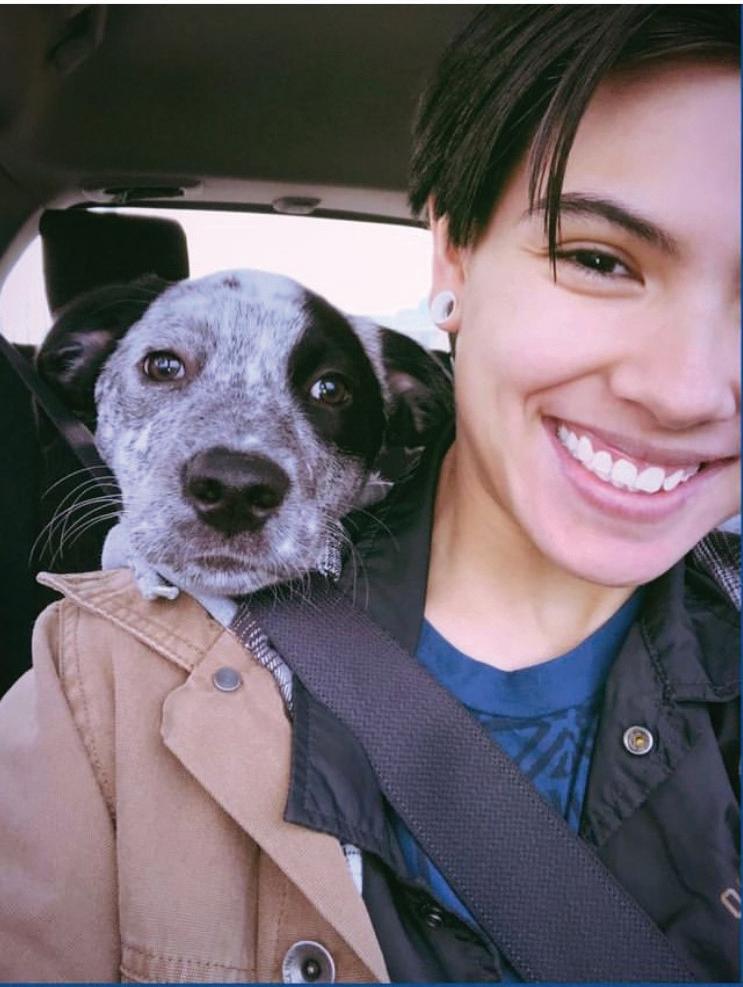
You can also place the scent container on the floor in the middle of a room. Lure your dog to the scent with treats or praise & only keep rewarding them for sniffing or touching the source. Once your dog is consistently finding the scent in easy - to - find places, move on to more challenging locations & introduce more scent boxes or containers for your dog to find.
You can use multiple scents & teach your dog to distinguish between different scents by presenting them with choices. Make a scent trail for your
dog by using a treat or a toy like a sheepskin or rabbit fur toy. Drag it along the ground to create a scent trail for your dog to follow & it is good to guide your dog with a leash when doing a scent trail.
It all sounds fun & easy, hide scents for my dog reward my dog for choosing or finding the correct scent. It takes patience & staying consistent with your training. Give your dog the time to gradually learn throughout the process using the positive reinforcement method. I’m sharing this as a fun & beneficial way you can train your dog at home, however if you do want you or your dog to become professionals in scent work consult with a nose work trainer or take a class.





Get ready to spark your spirit!
The 4th of July isn’t just about fireworks and hot dogs it’s about feeling free, having fun, and celebrating YOU. This year, let your liked songs on Spotify pick your personal anthem.
How to play:
1. Open Spotify and go to your “Liked Songs” playlist.
2. Hit shuffle.
3. The first song you hear? That’s your Firework Anthem!
Ask yourself:
• What does this song make you feel?
• Does it remind you of a memory with your family?
• If this song were a firework, what would it look like?
Now draw it! Create a firework that matches your song’s feeling. Is it sparkly? Loud? Colorful? Sweet?
Family Challenge:
Share your firework anthem and drawing with your family. Let them shuffle their songs too. Whose anthem is the most exciting? Whose is the funniest?
Star Playlist Shuffle: Let Your Songs Guide Your Day
Happy Fourth of July, shining star! Did you know the music you love can help guide how you spend your holiday? Let’s find out what kind of day your favorite songs want you to have!
How it works:
1. Go to your “Liked Songs” on Spotify.
2. Hit shuffle and listen to three songs in a row.
Now ask:
• Is your playlist fast or slow?
• Does it make you want to dance or chill?
• What activities match your playlist’s energy?
Your Song-Powered Holiday Plan:
• Song 1 = Morning move! (Dance, make a flag, do stretches)
• Song 2 = Afternoon action! (Family game, picnic, write a thank-you card)
• Song 3 = Firework finale! (Sing your favorite song out loud, or watch fireworks while imagining this song in the sky!)





Reflection Question:


What does freedom mean to you, and how do your songs help you feel it?
Freedom Beats: What Do Your Liked Songs Say About You?
Let’s celebrate YOU this 4th of July! Your Spotify playlist is more than just music—it’s a reflection of your heart, your dreams, and your joy. Let’s press shuffle and see what your freedom beats are telling you today.
Step 1: Open your “Liked Songs” and hit shuffle. Write down the first word that comes to mind for each of the first three songs.
Example:
1. “Brave”
2. “Family”
3. “Hopeful”
Now fill in the blanks:
• I am ________ like my songs.
• This holiday, I want to ________ more.
• If I had a Fourth of July superpower, it would be ________.



It’s July school’s out, the sun is shining, and adventure is waiting for YOU! This month is bursting with fun things to do, people to celebrate, and reasons to smile. Whether you’re splashing in the pool, watching fireworks, or just hanging out in your backyard, July is the perfect time to try something new.
Let’s make this the best summer ever—with games, crafts, and fun you can do all month long!
Celebrate the Fourth Like a Pro
We all know the Fourth of July means fireworks, flags, and food—but it’s also about freedom and feeling proud of who you are. Here’s a way to celebrate in your own special style:
Activity: Make Your Own “Proud to Be Me” Poster
Get a piece of paper and draw a big star in the middle. Inside the star, write or draw 3 things that make you proud—like being a great big sister, helping your neighbor, or being awesome at skateboarding!
Then decorate it with red, white, and blue. Hang it on your wall to remind you how amazing you are.

Silly Summer Challenge: Watermelon Olympics!
Grab your friends or family and try these goofy watermelon games (with a grown-up’s help!):
1. Seed Spit Contest – See who can spit a seed the farthest!
2. Watermelon Wiggle – Try to eat a slice of watermelon with no hands.
3. Watermelon Toss – Use a soft ball or beanbag and play a tossing game, pretending it’s a juicy slice!
in the Sunshine
Summer isn’t just for play it’s also a great time to spread kindness. Pick one of these to do this week:
• Leave a happy note for your mail carrier.
• Make a lemonade stand and donate the money to a good cause.
• Draw a chalk message
outside that says something sweet like “You Matter!” or “You’re a Star!”
Summer Craft Corner: Nature Bracelets
Go outside and find fun nature things tiny leaves, flower petals, grass pieces, or feathers.
Here’s how to make it:
1. Wrap a piece of masking tape (sticky side out!) around your wrist like a bracelet.
2. Press your nature treasures onto the tape to make a one-of-a-kind bracelet!
Now you’ve got a cool piece of summer to wear all day.
End-of-Day Magic: Your July Journal
Before bed, try this journaling prompt each night:
“Today, the sun made me feel ____. I laughed when ____. I’m thankful for ____.”
Even if you just draw your answers, it’s a great way to keep track of your summer memories.
Stay cool, stay kind, and keep having fun!



Summer is the perfect time for fun and for doing good! When the sun is shining and school is out, its a great chance to help others and make your neighborhood a happier place.
You don’t have to do something big to make a difference. Even small acts of kindness matter! You can team up with your family or friends and pick one fun project this summer to help someone else.
Here are some cool ideas:
• Lemonade for a Cause: Set up a lemonade stand and donate the money to an animal shelter or children’s hospital.
• Park Cleanup Crew: Grab gloves and a trash bag and clean up your local park or playground.
• Kindness Rocks: Paint happy messages on rocks and leave them for people to find.
• Snack Packs for the Homeless: Help your family make snack bags with water, granola bars, and a kind note to give to people in need.
Helping others feels amazing and it’s a fun way to spend time with your family too.

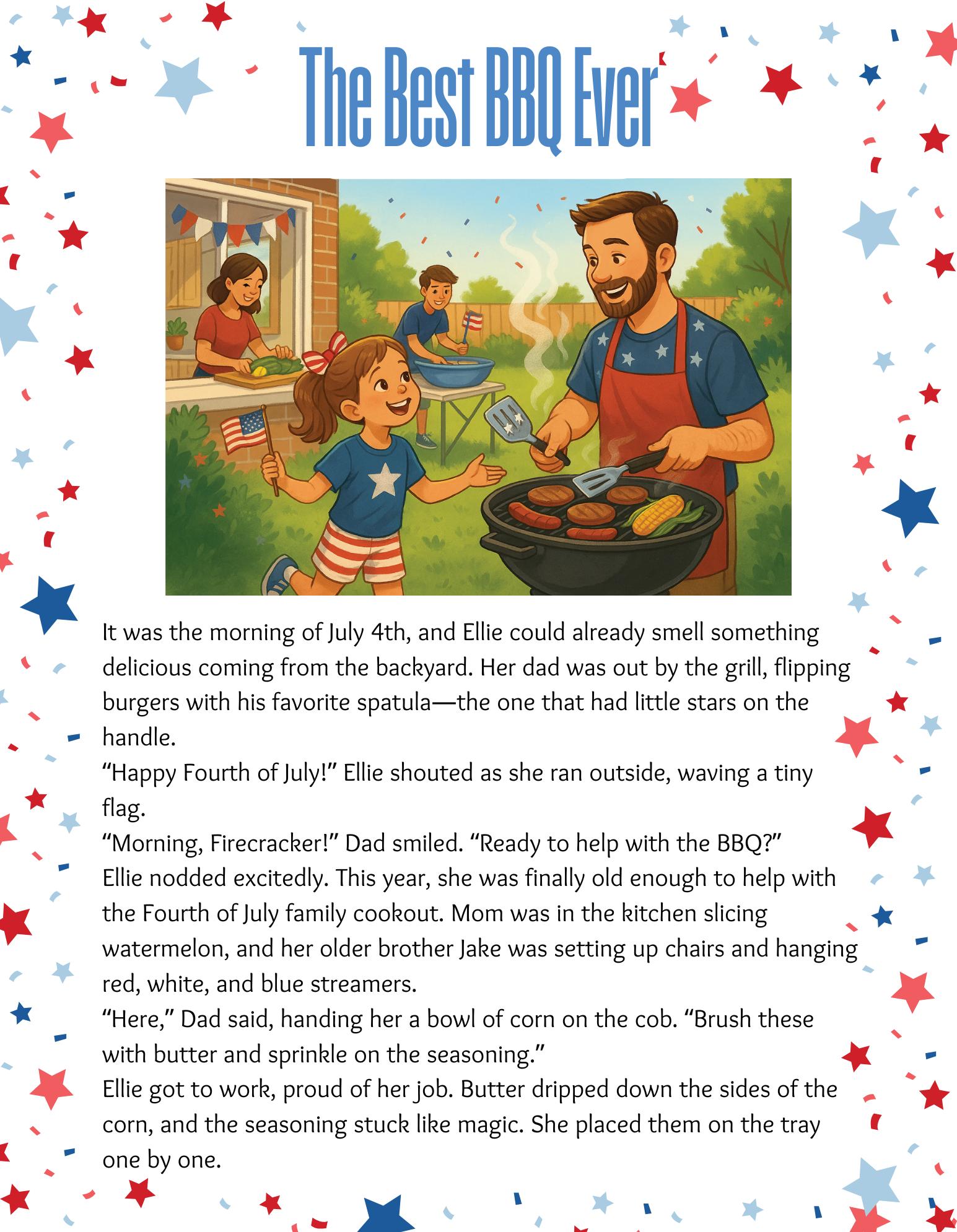





This treat is easy to make, healthy for you, and a great treat to cool off in the hot summer sun. The only downside of this recipe is waiting for it to freeze.
First, things first! Let’s get happy! If you can, turn on your favorite music and get ready to dance in the kitchen! And don’t forget to say a little blessing while you create this. Everyone will taste your gratitude and happiness.






What you will need for the Carnivore Chips:
• 1 cookie sheet
• 1 small mixing bowl
• 1 spatula or big spoon to mix
• Parchment paper
• 1 ½ cups of Greek yogurt
• ½ cup of raspberries
• ½ cup of blueberries
• 2 tablespoons of maple syrup or honey
• 1 teaspoon of vanilla extract
Directions:
1. Mix together the Greek yogurt, maple syrup (or honey) and vanilla extract in your mixing bowl.
2. Place parchment paper on your cookie sheet.
3. Pour your Greek yogurt mixture onto your parchment paper on your cookie sheet. Spread it out evenly.
4. Put your raspberries and blueberries all over your yogurt.
5. Place in your freezer for at least 3 hours.
6. Once frozen, you can take it out of the freezer and break up your bark. (I like to break it all up instead of cutting it nicely…but you do whatever your heart desires)
7. Enjoy!!!!
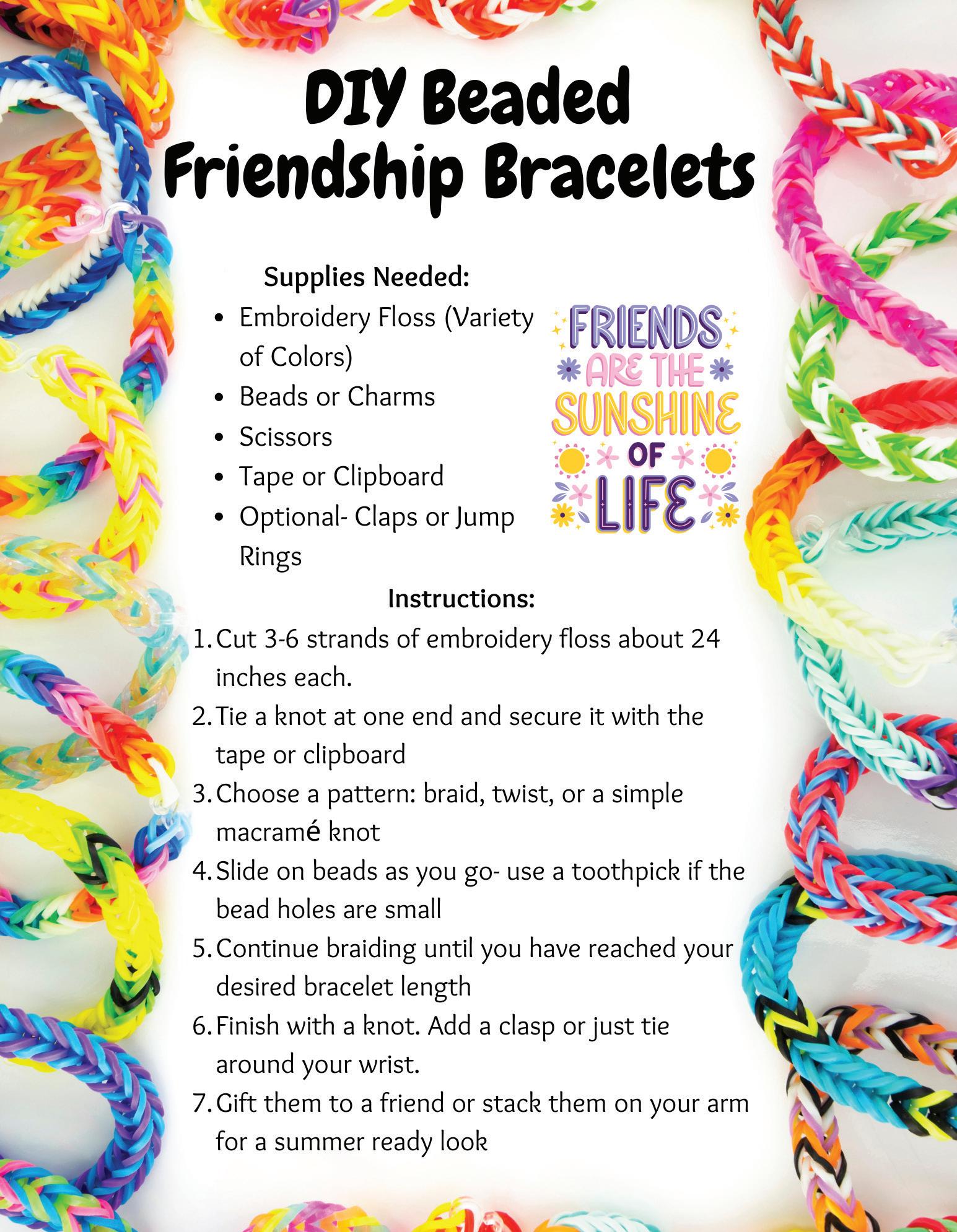






- SOPHIE, AGE 7, MADISON, WI
Sophie, that’s such a big, beautiful question. For kids, freedom can mean lots of things—like getting to play outside, choosing your favorite book to read, or being able to share your thoughts and dreams. In America, we celebrate freedom because it means every person has the right to be themselves. And that includes kids like you—curious, kind, and full of big ideas!
- JAYDEN, AGE 9, RENO, NV
Hi Jayden! What a great question! Fireworks have been part of Fourth of July celebrations since the very first one in 1777, just one year after the Declaration of Independence was signed. They were used to light up the sky in celebration of freedom, and today they still remind us of that joyful moment when America became its own country. Plus, they’re just really fun to watch! Every color and sparkle is a way to say, “Happy Birthday, America!”

- MALIK, AGE 10, ATLANTA, GA
Absolutely, Malik! The Fourth of July is about coming together, showing love for our country, and spending time with the people we care about. Whether you light sparklers, make red-white-and-blue pancakes, or just have a family movie night, it’s all about celebration your own way. There’s no one “right” way to be patriotic what matters most is making it meaningful to you.

